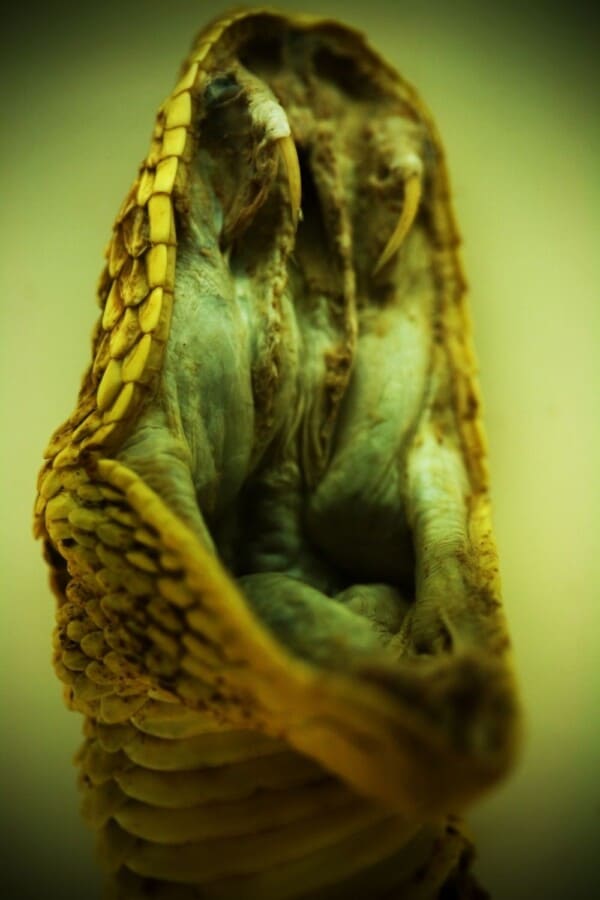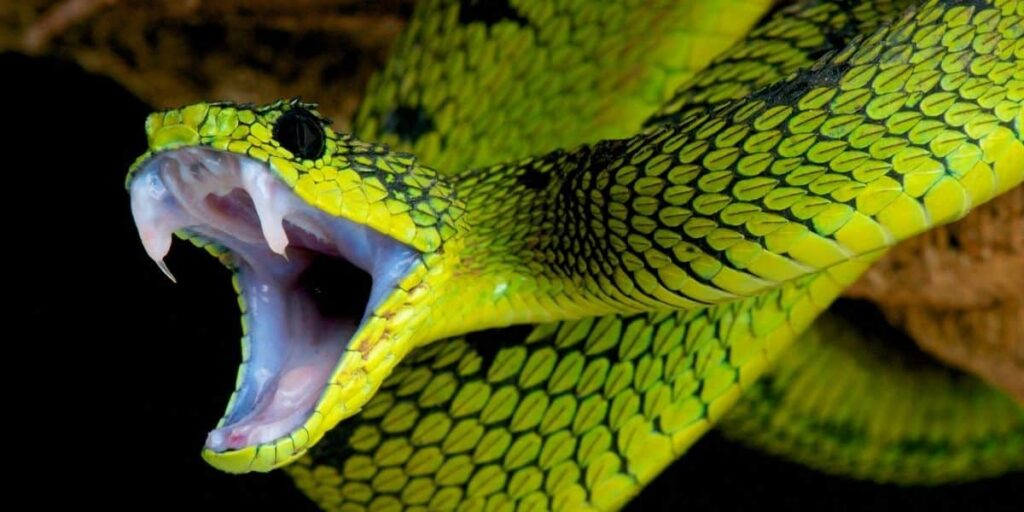Have you ever seen those movies with a killer snake that has a mouth full of enormous fangs, ready to penetrate the next unsuspecting victim? OK, that might be a little dramatic but there is a degree of truth in that imagery.
All snakes do have teeth, and in some cases, they can be quite large, but unlike in the movies, they are not simply poised and ready to bite. And those with larger teeth certainly won’t just bite you for the fun of it.
Snakes, much like many other animals have teeth to help them hunt venomous species, they often use them to inject toxins. However, despite their reputation, they aren’t quite as evil as they are perceived to be. Let’s explore.
Snake Teeth
It is important to point out that there is a difference between a snake’s teeth and a snake’s fangs. Although fangs are a type of teeth, they are only seen in poisonous species and are used for injecting venom into their prey; almost like a needle of sorts. But we will look at this in a little more detail later on.
Teeth, on the other hand, are much more similar to what we imagine when we think of these dental fixtures, and believe it or not, all snakes have them.
But unlike our teeth, these are not designed for chewing and snakes tend to swallow their prey whole. Their teeth are used as a way of pushing the food down towards the stomach.

However, the species and how it catches its prey will determine the type of teeth they have and how effective they are. All snakes have four rows of teeth in the upper jaw and two rows in the lower jaw.
The most interesting thing about this is that these teeth can regrow as many times as is needed because snake teeth will often fall out when they are feeding.
In snakes, the teeth are angled back towards the throat and for this reason, they are not always apparent when you first look at the animal.
What About Fangs
As we have mentioned, venomous snakes have fangs. Unlike regular teeth, these are long, pointed teeth that protrude from the jaw.
In some cases, larger snakes have quite significant fangs, and owing to their size, they are able to fold the fangs back inside the mouth bringing them out when they are needed. Without it, there would be a chance of the snake biting itself.
Fangs are a snake’s way of catching a meal and while they can look scary, it is worth keeping in mind that this is merely another of nature’s impressive creations.
Behind the snake’s eyes, there is a small sac that is filled with venom, this sac is connected to the fangs which are hollow. Once the snake has bitten its prey, the venom flows down the hollow fangs and into the prey, causing it to become paralyzed.
Much like the snake’s other teeth, fangs can break off but they will regrow.
Do Snakes Bite?
One of the main associations with snakes is that they will bite and kill a human without a second thought. Places like Australia that are filled with poisonous snakes and other animals get a bad reputation for being incredibly dangerous.
In reality, the number of snake deaths each year in this country is minimal. Records show that for every 550 people who go into hospital with a snake bite in the land down under, only two of these will become fatalities.
So, is there any reason to fear the fangs of the snake? Well, yes, if it is a poisonous snake then there would be no good reason to want to get bitten. But biting a human is never something that a snake wants to do. This is their last line of defense when they feel threatened.
In most cases, a snake will perform other behaviors before lashing out and biting. This usually gives you plenty of time to back away; and remember, a snake will be much more frightened of you so if you do encounter one in the wild, try not to panic.

Before using its fangs, a snake will likely hiss, raise itself off the floor and make itself appear aggressive. It will only go on to bite you if you do not submit and move away.
In the wild, remember that if you are confronted by a snake, you should not turn your back but rather back away with the snake in sight.
Pet snakes on the other hand are much less likely to show aggression, particularly those who have been bred in captivity. Of course, when you first get your snake, he may be a little nervous and it is not uncommon for snakes to show some signs of aggression when they are frightened, so be sure to give your pet plenty of time to settle in.
One of the most common snakes kept as a pet is the corn snake. This is because these are very docile animals and do not typically bite unless they feel threatened or mistake your finger for food.
What To Do If You Are Bitten
If you are bitten by a wild snake, you should always seek medical attention, even if you feel well. The bite wound could be infected with bacteria and this could cause problems down the line.
However, since keeping poisonous snakes in captivity is illegal without a license, we would assume that your pet is not poisonous. However, that doesn’t mean to say that a bite won’t break the skin or be painful.
If your snake gives you a nip, the first thing you should do is pop the snake back into her enclosure, it is likely that she lashed out because she was scared. Putting her where she feels safe is a good way to calm her down.
Now you will need to wash the area with soap and clean, warm water. You might also want to use an anti-septic to ensure that the wound is clean before dressing it.
For the most part, the wound won’t be serious, but if it continues to bleed or there are any other complications, be sure to get it checked out.
Conclusion
Snakes are common pets and there are thousands of species in the wild. These slithery friends have a reputation for biting and as such, this causes us to think about their teeth.
All snakes have teeth but it is only those that are venomous which have fangs. These are the ones that people think about when thinking about snakes’ teeth.
It is unlikely that your pet will bite you unless they feel threatened but if they do, it is important to clean the wound so that it doesn’t become infected.
- Are Garter Snakes Friendly? Here’s What You Need to Know
- Ball Python Continually Opening Mouth. Causes and Solutions
- Do Ball Pythons Live Underground? Exploring the Natural Habitat of Ball Pythons
- Do I Need to Mist a Ball Python Tank? A Clear Answer
- Ball Python Body Language: Understanding Your Pet’s Nonverbal Communication




